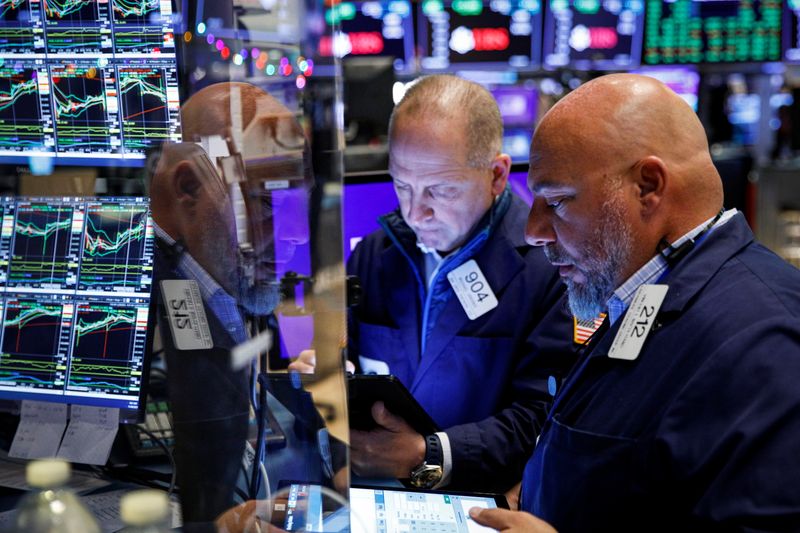By Devik Jain, Shreyashi Sanyal and Alden Bentley
(Reuters) - The Dow led Wall Street shares higher on Monday, as economy-linked banks and energy stocks charged back and fear about the Omicron variant eased, even as investors braced for another roller-coaster ride like last week's.
The tech-heavy Nasdaq was also up but lagged the Dow and S&P 500's gains, facing early headwinds from chipmakers mainly due to a slide in Nvidia.
All of the 11 major S&P 500 sectors advanced, with financials, energy and industrials up 2% or more, underscoring leadership of cyclical stocks, while defensive utilities were also up by a similar amount.
JJ Kinahan, chief market strategist at TD (TSX:TD) Ameritrade, said that some rotation was going on. Investors were favoring value shares over growth and also looking ahead to Dec. 17's big expiration of options and futures, referred to as a "quad" witching.
"You have a lot of firms that have a double mandate right now. You are trying to take off risk, expiration related, while the same time rebalancing your portfolio heading into 2022," he said.
By 1:42 p.m. ET, the Dow Jones Industrial Average rose 752.06 points, or 2.17%, to 35,332.14, the S&P 500 gained 70.52 points, or 1.55%, to 4,608.95 and the Nasdaq Composite added 174.91 points, or 1.16%, to 15,260.38.
The S&P 500 Value Index was up about 2% while its growth counterpart was up 1.1%.
Blue-chip stocks such as Honeywell International (NASDAQ:HON), Chevron Corp (NYSE:CVX), Goldman Sachs (NYSE:GS), 3M (NYSE:MMM) Co and Boeing (NYSE:BA) Co gained between 1.9% and 3.5%, powering the Dow Jones Industrial Average higher.
"If today's strength in the blue-chips can sort of sustain itself, that might give the rest of the market the ability to start to feel confident," said Robert Pavlik, senior portfolio manager at Dakota Wealth Management.
Wall Street's major indexes swung wildly last week as investors digested news of the COVID-19 Omicron variant and Federal Reserve Chair Jerome Powell's hawkish comments about a speedier taper to tackle surging inflation.
"Some of the news on the variant not being quite as severe as people had thought also has put a little bit of confidence in it," Kinahan said.
Goldman Sachs on Saturday cut its outlook for U.S. economic growth to 3.8% for 2022, citing risks and uncertainty around the emergence of Omicron. Investors also braced for a potential hit to corporate earnings, particularly among retailers, restaurants and travel companies.
The largest percentage gainer on the S&P 500 was Norwegian Cruise Line, which rose 12.1%, while the largest decliner was Moderna Inc, down 15.9%.
Among the most active stocks on the NYSE were Ford Motor (NYSE:F) Co, up 1.4% to $19.42; Palantir Technologies (NYSE:PLTR), down 0.6% to $18.87 and Nio Inc, down 0.3% to $32.05.
Nvidia was down 2.8%, still pressured by regulator concerns about its deal to buy British chip firm ARM Ltd. Peers Qualcomm (NASDAQ:QCOM) Inc and Advanced Micro Devices (NASDAQ:AMD) Inc pared early losses, as did the Philadelphia SE Semiconductor index which was last off 0.2%.
Tesla Inc (NASDAQ:TSLA) fell sharply after Reuters reported the U.S. SEC has opened a probe into the electric-car maker over whistleblower claims on solar panel defects, but pared early losses and was last off 0.8%.
Kohl's Corp (NYSE:KSS) jumped 6.7% after hedge fund Engine Capital LP said it was pushing the department-store chain to consider a sale of the company or separate its e-commerce division to improve its lagging stock price.
Advancing issues outnumbered declining ones on the NYSE by a 3.21-to-1 ratio; on Nasdaq, a 1.81-to-1 ratio favored advancers.

The S&P 500 posted 20 new 52-week highs and one new low; the Nasdaq Composite recorded 23 new highs and 582 new lows.
(This story corrects name spelling to Kinahan in paragraphs 4 and 11)